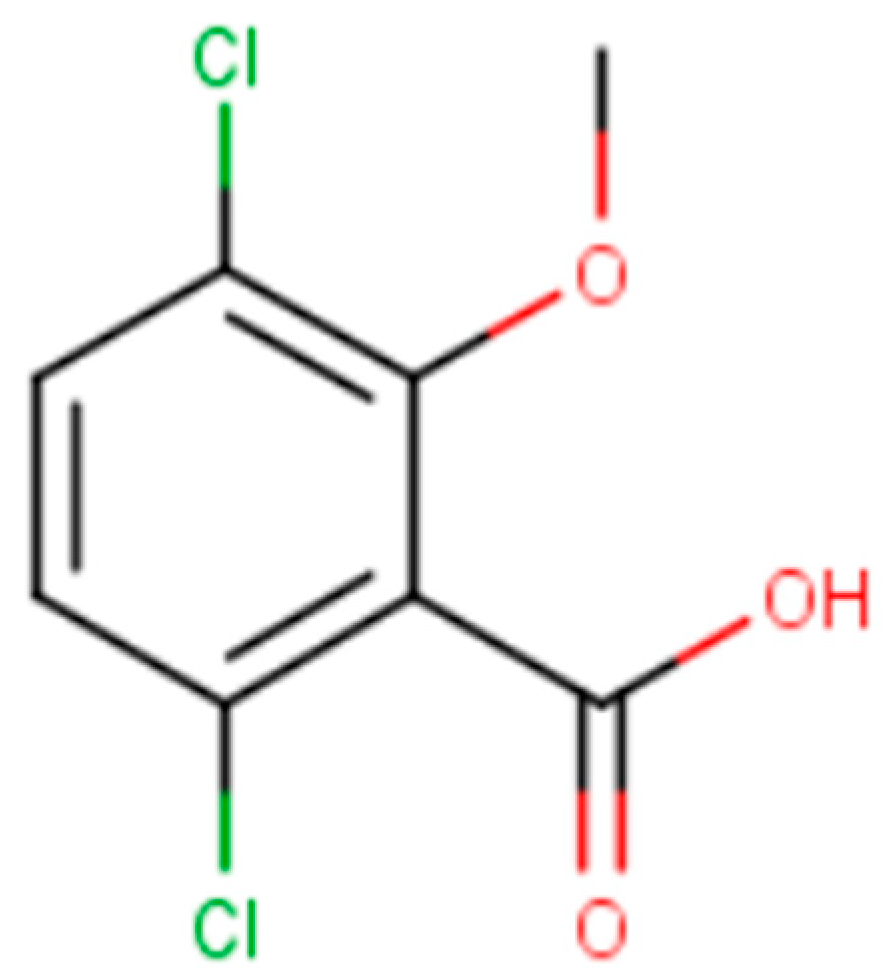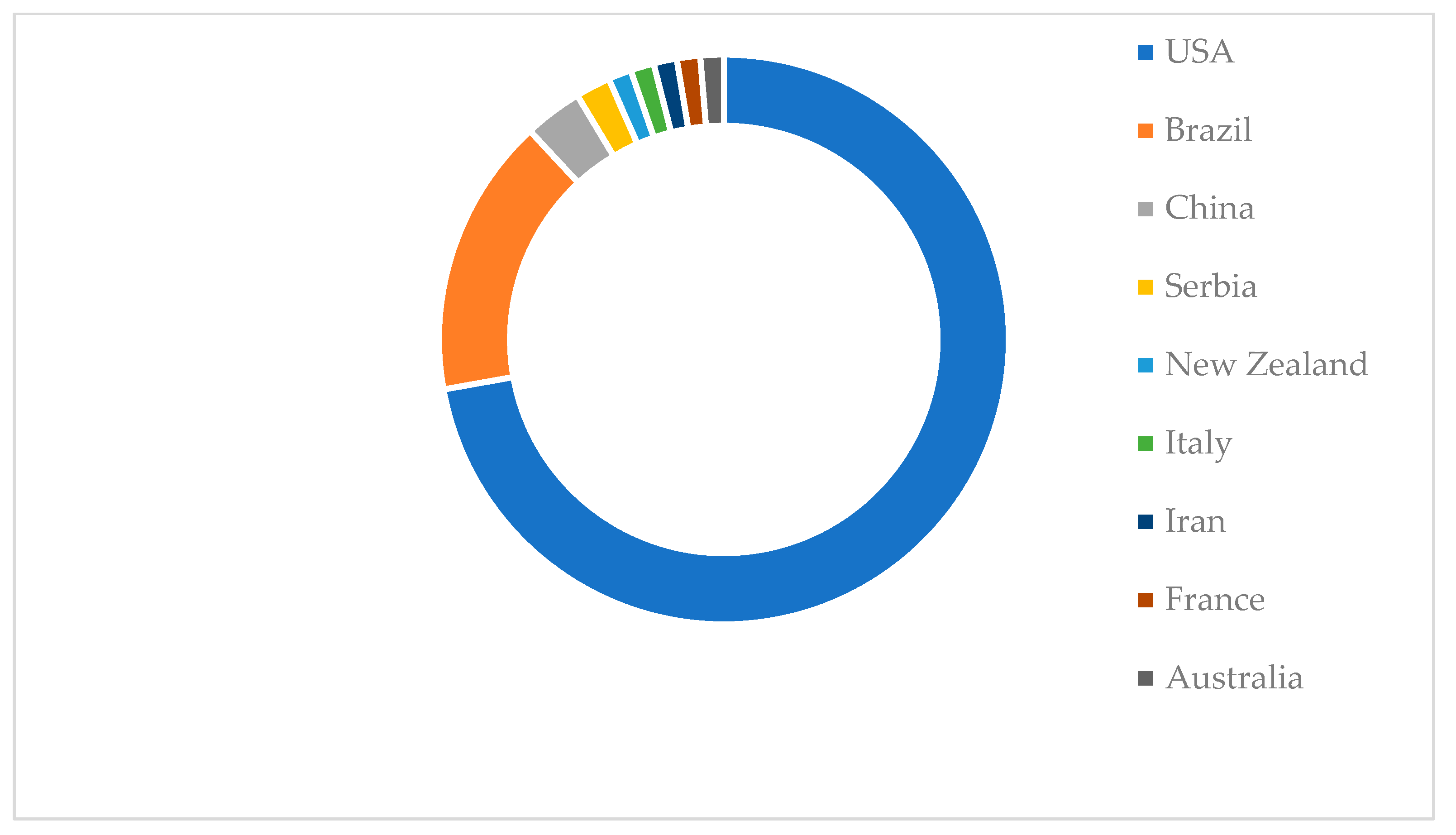Chemical Weed Control and Crop Injuries Due to Spray Drift: The Case of Dicamba
Abstract
:1. Introduction
2. Chemical Properties, Structure, and Volatility
2.1. Chemical Properties and Structure
2.2. Volatility and Spray Drift
3. Crop Damage Due to Dicamba Drift
4. Conclusions
Funding
Conflicts of Interest
References
- Bunch, T.R.; Gervais, J.A.; Buhl, K.; Stone, D. Dicamba Technical Fact Sheet; National Pesticide Information Center, Oregon State University Extension Services. 2012. Available online: https://npic.orst.edu/factsheets/archive/dicamba_tech.html (accessed on 20 November 2023).
- Carbonari, C.A.; Costa, R.N.; Giovanelli, B.F.; Velini, E.D. Evaluating methods and factors that affect dicamba volatility. Adv. Weed Sci 2022, 40, e020220014. [Google Scholar] [CrossRef] [PubMed]
- Egan, J.F.; Mortensen, D.A. Quantifying vapor drift of dicamba herbicides applied to soybean. Environ. Toxicol. Chem. 2012, 31, 1023–1031. [Google Scholar] [CrossRef] [PubMed]
- Bohnenblust, E.W.; Vaudo, A.D.; Egan, J.F.; Mortensen, D.A.; Tooker, J.F. Effects of the herbicide dicamba on nontarget plants and pollinator visitation. Environ. Toxicol. Chem. 2016, 35, 144–151. [Google Scholar] [CrossRef] [PubMed]
- Mueller, T.; Steckel, L. Dicamba volatility in humidomes as affected by temperature and herbicide treatment. Weed Technol. 2019, 33, 541–546. [Google Scholar] [CrossRef]
- Corbett, J.; Askew, S.; Thomas, W.; Wilcut, J. Weed efficacy evaluations for bromoxynil, glufosinate, glyphosate, pyrithiobac, and sulfosate. Weed Technol. 2004, 18, 443–453. [Google Scholar] [CrossRef]
- Wasacz, M.; Ward, D.; VanGessel, M.; Besançon, T. Sensitivity to sublethal rates of dicamba for selected mid-Atlantic vegetable crops. Weed Technol. 2022, 36, 207–213. [Google Scholar] [CrossRef]
- Soltani, N.; Oliveira, M.C.; Alves, G.S.; Werle, R.; Norsworthy, J.K.; Sprague, C.L.; Young, B.G.; Reynolds, D.B.; Brown, A.; Sikkema, P.H. Off-target movement assessment of dicamba in North America. Weed Technol. 2020, 34, 318–330. [Google Scholar] [CrossRef]
- Caux, P.-Y.; Kent, R.A.; Tache, M.; Grande, C.; Fan, G.T.; MacDonald, D.D. Environmental fate and effects of dicamba: A Canadian perspective. Rev. Environ. Contam. Toxicol. Contin. Residue Rev. 1993, 133, 1–58. [Google Scholar]
- Griffin, J.; Bauerle, M.; Stephenson, D.; Miller, D.; Boudreaux, J. Soybean response to dicamba applied at vegetative and reproductive growth stages. Weed Technol. 2013, 27, 696–703. [Google Scholar] [CrossRef]
- McCown, S.; Barber, T.; Norsworthy, J. Response of non–dicamba-resistant soybean to dicamba as influenced by growth stage and herbicide rate. Weed Technol. 2018, 32, 513–519. [Google Scholar] [CrossRef]
- National Center for Biotechnology Information. PubChem Compound Summary for CID 3030, Dicamba. 2023. Available online: https://pubchem.ncbi.nlm.nih.gov/compound/Dicamba (accessed on 8 November 2023).
- Behrens, R.; Lueschen, W. Dicamba volatility. Weed Sci. 1979, 27, 486–493. [Google Scholar] [CrossRef]
- Ouse, D.G.; Gifford, J.M.; Schleier, J.; Simpson, D.D.; Tank, H.H.; Jennings, C.J.; Annangudi, S.P.; Valverde-Garcia, P.; Masters, R.A. A new approach to quantify herbicide volatility. Weed Technol. 2018, 32, 691–697. [Google Scholar] [CrossRef]
- Oseland, E.; Bish, M.; Steckel, L.; Bradley, K. Identification of environmental factors that influence the likelihood of off-target movement of dicamba. Pest Manag. Sci. 2020, 76, 3282–3291. [Google Scholar] [CrossRef] [PubMed]
- Alves, G.S.; Kruger, G.R.; Cunha, J.P.A.R.; Santana, D.G.; Pinto, L.A.T.; Guimarães, F.; Zaric, M. Dicamba spray drift as influenced by wind speed and nozzle type. Weed Technol. 2017, 31, 724–731. [Google Scholar] [CrossRef]
- Kruger, G.R.; Alves, G.S.; Schroeder, K.; Golus, J.A.; Reynolds, D.B.; Dodds, D.M.; Brown, A.E.; Fritz, B.K.; Hoffmann, W.C. Dicamba off-target movement from applications on soybeans at two growth stages. Agrosyst. Geosci. Environ. 2023, 6, e20363. [Google Scholar] [CrossRef]
- Brankov, M.; Vieira, B.C.; Rajkovic, M.; Simic, M.; Vukadinovic, J.; Mandic, V.; Dragicevic, V. Herbicide drifts vs. crop resilience-the influence of micro-rates. Plant Soil Environ. 2023, 69, 161–169. [Google Scholar] [CrossRef]
- France, O.W.; Norsworthy, J.K.; Roberts, T.; Ross, J.; Barber, T.; Gbur, E. Sensitivity of rice to low rates of glyphosate and glyphosate plus dicamba at multiple growth stages. Crop Forage Turfgrass Manag. 2022, 8, e20185. [Google Scholar] [CrossRef]
- Virk, S.S.; Sapkota, M.; Byers, C.; Morgan, G.; Barnes, E. Utility of hooded broadcast sprayer in reducing herbicide particle drift in cotton. J. Cotton Sci. 2023, 27, 127–139. [Google Scholar] [CrossRef]
- Daramola, O.S.; Kharel, P.; Iboyi, J.E.; Devkota, P. Response of peanut (Arachis hypogaea L.) to sublethal rates of dicamba plus glyphosate at different growth stages. Agron. J. 2023, 115, 1694–1704. [Google Scholar] [CrossRef]
- Warmund, M.R.; Ellersieck, M.R.; Smeda, R.J. Sensitivity and Recovery of Tomato Cultivars Following Simulated Drift of Dicamba or 2,4-D. Agriculture 2022, 12, 1489. [Google Scholar] [CrossRef]
- Meyers, S.; Arana, J.; Woolam, B.; Vargas, N.; Rodriguez, L.; Cardona, L. Dicamba residue persistence in processing tomato. Weed Sci. 2022, 70, 603–609. [Google Scholar] [CrossRef]
- Brooke, M.; Stenger, J.; Svyantek, A.; Auwarter, C.; Hatterman-Valenti, H. ‘Atlantic’ and ‘Dakota Pearl’ chipping potato responses to glyphosate and dicamba simulated drift. Weed Technol. 2022, 36, 15–20. [Google Scholar] [CrossRef]
- Batts, T.; Moore, L.; Ippolito, S.; Jennings, K.; Smith, S. Effect of simulated synthetic auxin herbicide sprayer contamination in sweetpotato propagation beds. Weed Technol. 2022, 36, 379–383. [Google Scholar] [CrossRef]
- Da Silva Brochado, M.G.; Mielke, K.C.; de Paula, D.F.; Souza Laube, A.F.; Alcántara-de la Cruz, R.; Pereira Gonzatto, M.; Ferreira Mendes, K. Impacts of dicamba and 2,4-D drift on ‘Ponkan’ mandarin seedlings, soil microbiota and Amaranthus retroflexus. J. Hazard. Mater. Adv. 2022, 6, 100084. [Google Scholar] [CrossRef]
- Haring, S.C.; Ou, J.; Al-Khatib, K.; Hanson, B.D. Grapevine Injury and Fruit Yield Response to Simulated Auxin Herbicide Drift. HortScience 2022, 57, 384–388. [Google Scholar] [CrossRef]
- De Carvalho, S.J.P.; Magalhaes, T.B.; Lopez Ovejero, R.F.; Palhano, M.G. Phytotoxicity of low doses of dicamba when sprayed in pre-emergence on non-tolerant soybean. Rev. Cienc. Agrovet. 2022, 21, 85–92. [Google Scholar]
- Ferreira, P.H.U.; Thiesen, L.V.; Pelegrini, G.; Ramos, M.F.T.; Pinto, M.M.D.; da Costa Ferreira, M. Physicochemical properties, droplet size and volatility of dicamba with herbicides and adjuvants on tank-mixture. Sci. Rep. 2020, 10, 18833. [Google Scholar] [CrossRef]
- De Oliveira, G.M.P.; Gandolfo, M.A.; de Oliveira, R.B.; de Oliveira, S.M.P.; Martins, V.A. Potential drift and injury of herbicides sprayed in a wind tunnel. Eng. Agric. 2019, 39, 75–82. [Google Scholar] [CrossRef]
- Jones, G.T.; Norsworthy, J.K.; Barber, T. Off-target movement of diglycolamine dicamba to non-dicamba soybean using practices to minimize primary drift. Weed Technol. 2019, 33, 24–40. [Google Scholar] [CrossRef]
- Brown, L.R.; Robinson, D.E.; Nurse, R.E.; Swanton, C.J.; Sikkema, P.H. Soybean response to simulated dicamba/diflufenzopyr drift followed by postemergence herbicides. Crop Prot. 2009, 28, 539–542. [Google Scholar] [CrossRef]
- Tian, F.; Vieira, C.C.; Zhou, J.; Zhou, J.; Chen, P. Estimation of Off-Target Dicamba Damage on Soybean Using UAV Imagery and Deep Learning. Sensors 2023, 23, 3241. [Google Scholar] [CrossRef] [PubMed]
- Marques, M.G.; da Cunha, J.P.A.R.; Lemes, E.M. Dicamba injury on soybean assessed visually and with Spectral Vegetation Index. AgriEngineering 2021, 3, 240–250. [Google Scholar] [CrossRef]
- Xie, C.; Li, X.J.; He, X.K.; Liu, Y.J. Droplet deposition and drift potential of typical flat fan nozzle and air induction nozzles. Int. J. Agric. Eng. 2020, 29, 51–59. [Google Scholar]
- Wang, S.; Li, X.; Nuyttens, D.; Zhang, L.; Liu, Y.; Li, X. Evaluation of compact air-induction flat fan nozzles for herbicide applications: Spray drift and biological efficacy. Front. Plant Sci. 2023, 14, 1018626. [Google Scholar] [CrossRef] [PubMed]
- De Cauwer, B.; De Meuter, I.; De Ryck, S.; Dekeyser, D.; Zwertvaegher, I.; Nuyttens, D. Performance of drift-reducing nozzles in controlling small weed seedlings with contact herbicides. Agronomy 2023, 13, 1342. [Google Scholar] [CrossRef]
- Grella, M.; Marucco, P.; Balafoutis, A.T.; Balsari, P. Spray drift generated in vineyard during under-row weed control and suckering: Evaluation of direct and indirect drift-reducing techniques. Sustainability 2020, 12, 5068. [Google Scholar] [CrossRef]
- Mueller, T.C.; Wright, D.R.; Remund, K.M. Effect of formulation and application time of day on detecting dicamba in the air under field conditions. Weed Sci. 2013, 61, 586–593. [Google Scholar] [CrossRef]
- Lan, Y.; Hoffmann, W.C.; Fritz, B.K.; Martin, D.E.; Lopez, J.D. Spray drift mitigation with spray mix adjuvants. Appl. Eng. Agric. 2008, 24, 5–10. [Google Scholar] [CrossRef]


| Chemical Formula | C8H8Cl2O3 |
|---|---|
| Molecular weight | 221.03 g/mol |
| Melting point | 200 °C |
| Boiling point | 114–116 °C |
| Solubility in water (25 °C) | 4500 mg/L |
| Crop | Reference |
|---|---|
| Soybean (Glycine max (L.) Merr.) | [7,17,18] |
| Rice (Oryza sativa L.) | [19] |
| Cotton (Gossypium hirsutum L.) | [20] |
| Peanut (Arachis hypogaea L.) | [21] |
| Tomato (Solanum lycopersicum L.) | [18,22,23] |
| Lettuce (Lactuca sativa L.) | [18] |
| Pumpkin (Cucurbita maxima Duch) | [18] |
| Oilseed rape (Brassica napus L.) | [18] |
| Pepper (Capsicum annuum L.) | [18] |
| Sunflower (Helianthus annuus L.) | [18] |
| Cucumber (Cucumis sativus L.) | [7] |
| Eggplant (Solanum melongena L.) | [7] |
| Snap bean (Phaseolus vulgaris L.) | [7] |
| Potato (Solanum tuberosum L.) | [24] |
| Sweetpotato (Ipomoea batatas (L.) Lam.) | [25] |
| Mandarin (Citrus reticulata) | [26] |
| Grapevine (Vitis vinifera L.) | [27] |
| Brazilian peppertree (Schimus terebinthifolius Raddi.) | [28] |
Disclaimer/Publisher’s Note: The statements, opinions and data contained in all publications are solely those of the individual author(s) and contributor(s) and not of MDPI and/or the editor(s). MDPI and/or the editor(s) disclaim responsibility for any injury to people or property resulting from any ideas, methods, instructions or products referred to in the content. |
© 2024 by the authors. Licensee MDPI, Basel, Switzerland. This article is an open access article distributed under the terms and conditions of the Creative Commons Attribution (CC BY) license (https://creativecommons.org/licenses/by/4.0/).
Share and Cite
Travlou, E.; Antonopoulos, N.; Gazoulis, I.; Kanatas, P. Chemical Weed Control and Crop Injuries Due to Spray Drift: The Case of Dicamba. Agrochemicals 2024, 3, 22-28. https://doi.org/10.3390/agrochemicals3010003
Travlou E, Antonopoulos N, Gazoulis I, Kanatas P. Chemical Weed Control and Crop Injuries Due to Spray Drift: The Case of Dicamba. Agrochemicals. 2024; 3(1):22-28. https://doi.org/10.3390/agrochemicals3010003
Chicago/Turabian StyleTravlou, Eleftheria, Nikolaos Antonopoulos, Ioannis Gazoulis, and Panagiotis Kanatas. 2024. "Chemical Weed Control and Crop Injuries Due to Spray Drift: The Case of Dicamba" Agrochemicals 3, no. 1: 22-28. https://doi.org/10.3390/agrochemicals3010003






